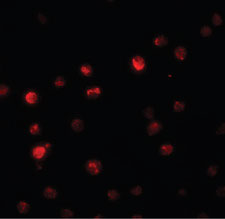PPAPDC2 Antibody (C-Terminus)
Rabbit Polyclonal Antibody
- SPECIFICATION
- CITATIONS
- PROTOCOLS
- BACKGROUND

Application
| WB, IHC-P, IF, E |
|---|---|
| Primary Accession | Q8IY26 |
| Reactivity | Human, Mouse, Rat |
| Host | Rabbit |
| Clonality | Polyclonal |
| Calculated MW | 32kDa |
| Dilution | IHC-P (5 µg/ml), WB (1-2 µg/ml), |
| Gene ID | 403313 |
|---|---|
| Other Names | Presqualene diphosphate phosphatase, 3.1.3.-, Phosphatidic acid phosphatase type 2 domain-containing protein 2, PPAP2 domain-containing protein 2, PPAPDC2 |
| Target/Specificity | Human PPAPDC2 |
| Reconstitution & Storage | Short term 4°C, long term aliquot and store at -20°C, avoid freeze thaw cycles. Store undiluted. |
| Precautions | PPAPDC2 Antibody (C-Terminus) is for research use only and not for use in diagnostic or therapeutic procedures. |
| Name | PLPP6 (HGNC:23682) |
|---|---|
| Function | Magnesium-independent polyisoprenoid diphosphatase that catalyzes the sequential dephosphorylation of presqualene, farnesyl, geranyl and geranylgeranyl diphosphates (PubMed:16464866, PubMed:19220020, PubMed:20110354). Functions in the innate immune response through the dephosphorylation of presqualene diphosphate which acts as a potent inhibitor of the signaling pathways contributing to polymorphonuclear neutrophils activation (PubMed:16464866, PubMed:23568778). May regulate the biosynthesis of cholesterol and related sterols by dephosphorylating presqualene and farnesyl diphosphate, two key intermediates in this biosynthetic pathway (PubMed:20110354). May also play a role in protein prenylation by acting on farnesyl diphosphate and its derivative geranylgeranyl diphosphate, two precursors for the addition of isoprenoid anchors to membrane proteins (PubMed:20110354). Has a lower activity towards phosphatidic acid (PA), but through phosphatidic acid dephosphorylation may participate in the biosynthesis of phospholipids and triacylglycerols (PubMed:18930839). May also act on ceramide-1-P, lysophosphatidic acid (LPA) and sphing-4-enine 1-phosphate/sphingosine- 1-phosphate (PubMed:18930839, PubMed:20110354). |
| Cellular Location | Endoplasmic reticulum membrane; Multi-pass membrane protein. Nucleus envelope. Nucleus inner membrane |
| Tissue Location | Widely expressed. Expressed in most organs, in particular gastrointestinal organs, spleen, placenta, kidney, thymus and brain. |

Thousands of laboratories across the world have published research that depended on the performance of antibodies from Abcepta to advance their research. Check out links to articles that cite our products in major peer-reviewed journals, organized by research category.
info@abcepta.com, and receive a free "I Love Antibodies" mug.
Provided below are standard protocols that you may find useful for product applications.
Background
Phosphatase that dephosphorylates presqualene diphosphate (PSDP) into presqualene monophosphate (PSMP), suggesting that it may be indirectly involved in innate immunity. PSDP is a bioactive lipid that rapidly remodels to presqualene monophosphate PSMP upon cell activation. Displays diphosphate phosphatase activity with a substrate preference for PSDP > FDP > phosphatidic acid.
References
Ota T.,et al.Nat. Genet. 36:40-45(2004).
Humphray S.J.,et al.Nature 429:369-374(2004).
Fukunaga K.,et al.J. Biol. Chem. 281:9490-9497(2006).
Burkard T.R.,et al.BMC Syst. Biol. 5:17-17(2011).
If you have used an Abcepta product and would like to share how it has performed, please click on the "Submit Review" button and provide the requested information. Our staff will examine and post your review and contact you if needed.
If you have any additional inquiries please email technical services at tech@abcepta.com.













 Foundational characteristics of cancer include proliferation, angiogenesis, migration, evasion of apoptosis, and cellular immortality. Find key markers for these cellular processes and antibodies to detect them.
Foundational characteristics of cancer include proliferation, angiogenesis, migration, evasion of apoptosis, and cellular immortality. Find key markers for these cellular processes and antibodies to detect them. The SUMOplot™ Analysis Program predicts and scores sumoylation sites in your protein. SUMOylation is a post-translational modification involved in various cellular processes, such as nuclear-cytosolic transport, transcriptional regulation, apoptosis, protein stability, response to stress, and progression through the cell cycle.
The SUMOplot™ Analysis Program predicts and scores sumoylation sites in your protein. SUMOylation is a post-translational modification involved in various cellular processes, such as nuclear-cytosolic transport, transcriptional regulation, apoptosis, protein stability, response to stress, and progression through the cell cycle. The Autophagy Receptor Motif Plotter predicts and scores autophagy receptor binding sites in your protein. Identifying proteins connected to this pathway is critical to understanding the role of autophagy in physiological as well as pathological processes such as development, differentiation, neurodegenerative diseases, stress, infection, and cancer.
The Autophagy Receptor Motif Plotter predicts and scores autophagy receptor binding sites in your protein. Identifying proteins connected to this pathway is critical to understanding the role of autophagy in physiological as well as pathological processes such as development, differentiation, neurodegenerative diseases, stress, infection, and cancer.


